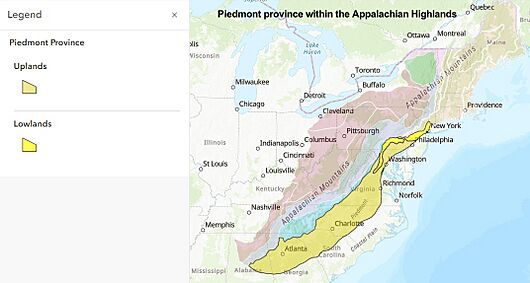Piedmont (United States) facts for kids
The Piedmont is a large, flat area of land called a plateau in the Eastern United States. It sits between the Atlantic Plain (which is flat land near the ocean) and the Blue Ridge Mountains. This region stretches a long way, from New York in the north all the way down to central Alabama in the south.
The Piedmont is part of a bigger area called the Appalachian Highlands. It has two main parts: the Piedmont Upland (higher ground) and the Piedmont Lowlands (lower ground).
On its eastern side, the Piedmont meets the Coastal Plain at a special line called the Atlantic Seaboard Fall Line. To the west, it is mostly bordered by the Blue Ridge Mountains. These mountains are the most eastern part of the Appalachians. The Piedmont's width changes a lot. It's quite narrow near the Delaware River but gets very wide, almost 300 miles (475 km), in North Carolina. The total area of the Piedmont is about 80,000 square miles (207,000 km²).
The name "Piedmont" comes from a French word. It means "foothill," which is a hill at the bottom of a mountain. This is similar to the name of a region in Italy called Piedmont (Piemonte), which is next to the Alps mountains.
Contents
What is the Piedmont's Geology?

The Piedmont landscape has gentle, rolling hills. These hills are usually between 200 feet (50 meters) and 1,000 feet (300 meters) above sea level. The geology of this area is quite complex. It has many different types of rocks from various time periods mixed together.
Basically, the Piedmont is what's left of several very old mountain chains. These mountains have worn down over millions of years. Geologists have found at least five major events that shaped the Piedmont. One important event was the Grenville orogeny, when continents crashed together to form the supercontinent Rodinia. Another was the Appalachian orogeny, which happened when the supercontinent Pangaea was forming.
The last big event for the Piedmont was when Pangaea started to break apart. As North America and Africa slowly moved away from each other, large basins formed. These basins were filled with sediment (like sand and mud) that washed down from the higher ground around them. Many of these Mesozoic-era basins are found almost entirely within the Piedmont region today.
Piedmont Soils and Farming
The soil in the Piedmont is generally clay-like and quite fertile. It's known as Ultisols. However, in some places, the soil has been damaged by erosion and too much farming. This was especially true in the southern Piedmont, where cotton was a very important crop for a long time.
In the central Piedmont areas of North Carolina and Virginia, tobacco is the main crop grown. Further north, farming is more varied. You can find orchards (where fruit trees grow), dairy farms (for milk products), and general farming.
Piedmont Blues Music
The southern part of the Piedmont region is famous for a type of music called Piedmont blues. This style of blues music started there in the late 1800s. Many Piedmont blues musicians came from states like Virginia, North and South Carolina, and Georgia.
During the Great Migration, many African Americans moved to the Piedmont. Because the Appalachian Mountains were to the west, people often stayed in cities instead of spreading out into rural areas. This meant they heard many different kinds of music. So, Piedmont blues was influenced by styles like ragtime, country music, and popular songs. These influences were stronger here than in other blues regions, like the rural Mississippi Delta.
Major Cities in the Piedmont
Many big cities are located along the Atlantic Seaboard fall line. This line is the eastern edge of the Piedmont. In Georgia and Alabama, where the Piedmont runs more from east to west, the fall line is its southern border.
The fall line is where the land suddenly rises from the flat coastal plain. It also marks the point where many major rivers become too shallow for large boats to travel further inland. Because of this, many important port cities grew up along this line.
Within the Piedmont region itself, there are several large urban areas:
- The Atlanta metropolitan area in Georgia is the biggest.
- The Piedmont also cuts through Maryland, covering the Baltimore–Washington metropolitan area.
- In Virginia, the Greater Richmond metropolitan area is the largest city area.
- In North Carolina, the Piedmont Crescent includes several big city groups. These are the Charlotte metropolitan area, the Piedmont Triad, and the Research Triangle.
- Other important areas include the Greenville-Spartanburg-Anderson, SC Combined Statistical Area in South Carolina.
- The Philadelphia metropolitan area in Pennsylvania is also partly in the Piedmont.
See also
 In Spanish: Piedmont (región de Estados Unidos) para niños
In Spanish: Piedmont (región de Estados Unidos) para niños



